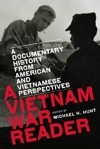 Editor Michael Hunt is a former college professor who has written extensively on 20th-century U.S. history. He also taught a Vietnam War course for 30 years. Vietnam War Reader is a collection of 102 documents that focus on the Americans and Vietnamese who fought the war. Its purpose is to illustrate to students and teachers the various perspectives on the conflict in order to gain an understanding of this controversial struggle. By keeping his “own views on a leash,” Hunt intends for this collection of primary source material to allow the war’s participants to speak directly to readers. As editor, Hunt provides brief but insightful overviews of the themes and issues raised in each chapter.
Editor Michael Hunt is a former college professor who has written extensively on 20th-century U.S. history. He also taught a Vietnam War course for 30 years. Vietnam War Reader is a collection of 102 documents that focus on the Americans and Vietnamese who fought the war. Its purpose is to illustrate to students and teachers the various perspectives on the conflict in order to gain an understanding of this controversial struggle. By keeping his “own views on a leash,” Hunt intends for this collection of primary source material to allow the war’s participants to speak directly to readers. As editor, Hunt provides brief but insightful overviews of the themes and issues raised in each chapter.
In his introduction, Hunt describes how Hollywood films became the single most important source of information on the war for Americans. These movies, as well as polling data from the postwar period, show popular conceptions of the war focus on what the war did to our country and our soldiers during the period of direct U.S. engagement, and have little room for the impact of the war on Vietnam and the Vietnamese. The documents cover the period from 1861 to the end of the 20th century, and show there was a lot more to the war than was contained in the American popular view of it. Given how the war is portrayed through American eyes, it is appropriate that this collection gives equal space to the Vietnamese point of view (even though less than 10 percent of the documents represent the South Vietnamese viewpoint). The documents clearly show that Vietnamese on both sides of the DMZ considered Vietnam to be one country temporarily divided, even as the United States worked to make that division permanent. Most of the documents are official U.S. and Vietnamese documents, and give perspectives on the war from senior government officials.
In the chapter titled “The View from the Ground,” Hunt offers accounts not from those who initiated the war but from those who fought it. America’s ignorance of Vietnamese culture is made evident by one soldier who wrote his parents how “the people live like pigs” in houses that are “rundown shacks.” Another felt the Viet Cong were better soldiers than those who fought for the South Vietnamese government (ARVN) and noted how the Americans always took the brunt of battle. Initially bullish, this soldier concluded that the war had no purpose: “All we’re doing is killing each other.” A 19-year-old Marine, apparently with no sense of irony, wrote how he was “pissed off how this war is dragging on.” No doubt many Vietnamese agreed. An Army lieutenant claimed most of the soldiers he served with “hated the [South] Vietnamese.” The accounts by U.S. soldiers mostly have an “us-as-victim” theme, revealing little compassion for the Vietnamese. An interview with a South Vietnamese man shows the dilemma confronting civilians. He was forced to join the ARVN, deserted, was then punished by the Viet Cong for being ARVN, forced back into the ARVN, punished again by the VC, and finally arrested and imprisoned, by the Americans, for reasons unknown.
Hunt has put together a first-rate collection of documents. His editorial comments are most helpful and illustrate his broad knowledge of the war in Vietnam. He succeeds in his goal of illustrating the various perspectives of the conflict.
Although aimed at students and teachers, Vietnam War Reader will be a real eye-opener for anyone interested in learning how the Americans and Vietnamese went to war with one another, the nature and impact of the fighting, and the long-term consequences of the conflict on both sides.
University of North Carolina Press, 2010




